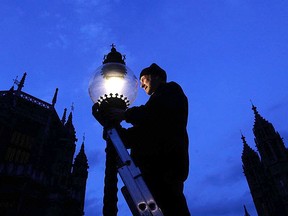In a world full of lights, it is easy to forget the extreme darkness early area settlers endured, outside and inside their homes.

On Dec. 26, 1872, manufactured gas arrived in the town of Chatham and was quickly adapted for use in street lighting. Lamps were lit at dusk and extinguished at daybreak.
Advertisement 2
Article content
Two men were assigned this task and their work initially focused on King Street, which had the most gas lights. There may have been a few on other streets and perhaps three, strategically placed, in upscale residential areas like Victoria Avenue and King Street West. But outside town, it was dark.
Article content
In a world full of lights, it is easy to forget the extreme darkness early area settlers endured, outside and inside their homes.
The average town or village was virtually pitch black and the few fledgling North American cities were usually lit with little more than a few torches or cressets, post-mounted wire baskets in which kindling was burned to produce light.
In the average Chatham-Kent pioneer home, a candle or two would be lit at night — only a handful had oil lamps — to dimly light the main part of the home. Homes were essentially dark at night until well into the 1800s. Though a number of tasks were completed effectively and with great skill and dexterity by these meagre light sources, the average citizen of today would have been totally lost.
Advertisement 3
Article content
Outside the home, there may have been a lantern or two on a hook near a doorway or in the barn; sometimes there were crude torches. These were used primarily when guests were expected or work had to be done outside.
Add the element of darkness to a paragraph from Victor Lauriston’s book Romantic Kent and you will get a little clearer picture of life after dark in Chatham-Kent:
“Wolves were a terror in the land; and at certain seasons no woman’s life, much less a child’s was safe on the trail after nightfall. Even in daylight, sheep were in constant danger and after dark, all young stock had to be penned. The nights were often made hideous by the unearthly howling of the wolves as they prowled about the enclosures, or tried to stampede belated cattle. One man from Dover Township recorded that he had killed 24 wolves (there was a bounty of their scalps) and it was only April!
Advertisement 4
Article content
No one ventured outside at night without a lantern until well into the 1800s. The 1843 Manual of Domestic Economy said, “Every house should be provided with one or more lanterns to carry out of doors at night, or to take into a stable, barn or any other place where an uncovered candle or lamp might be dangerous.”
“… Lanterns with glass sides are so easily cracked (early glass was notoriously poor) that we do not recommend them. They are much better when glazed with horn (shavings from cattle horns provided a durable, translucent lantern window) or perforated all over with small holes,” it added.
“If they have (oil) lamps in them, care should be taken to trim and replenish these daily, that the lanterns can always be ready if wanted at night. Those using candles in their lanterns must be careful to use shorter candles, for if the candle is too long it will heat the top of the lantern and that will result in burnt fingers of the person who carries it.”
As you can imagine, the arrival of manufactured gas in Chatham street lights would have had a dramatic impact on travel at night. Out of town, it remained dark until much later; even today, a night walk down a tree-lined country road can be rather frightening.
Next time you do this, imagine what it would have been like for early settlers to our area, then imagine the sound of numerous hungry wolves howling nearby. The quiet country life, without sound, lights and people, may have a rather romantic appeal, but, as is often the case, it’s more romantic to ponder it than endure it.
Article content